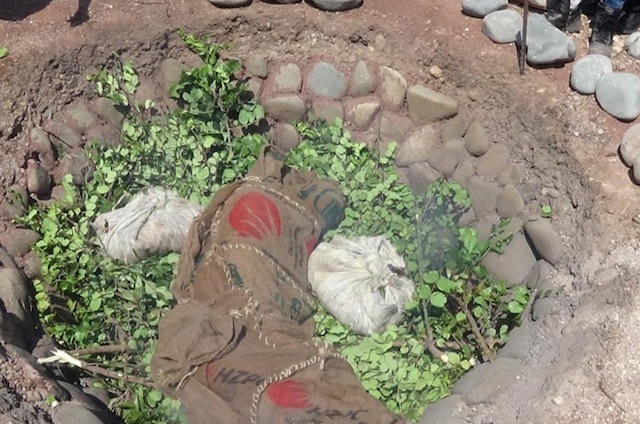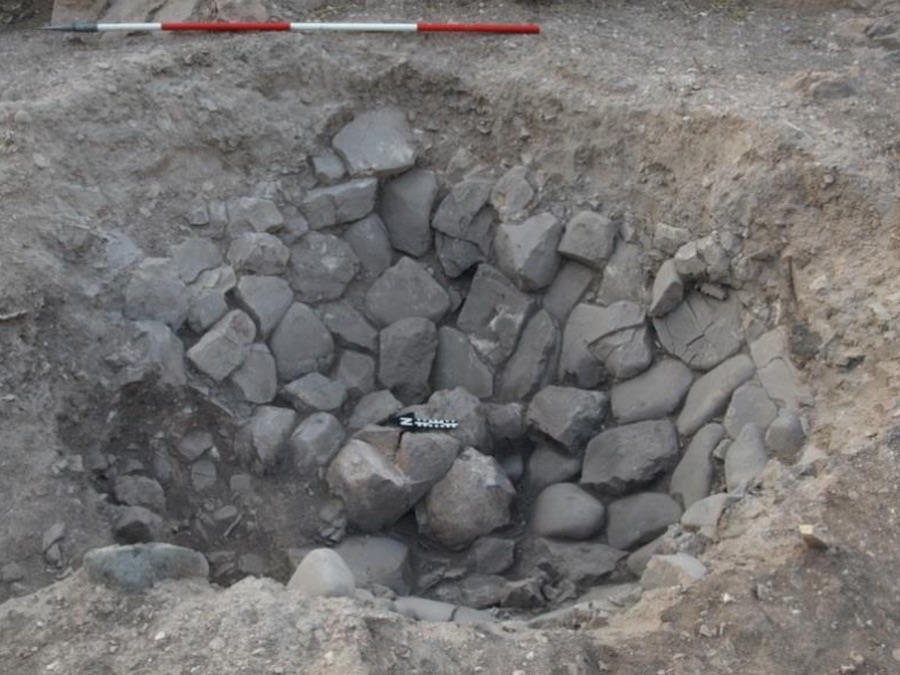Recreated Pit Roast Offers a Taste of Stone Age Life

Before there was pottery in Cyprus, there was barbecue.
And in the spirit of the Stone Age, archaeologists on the Mediterranean island recreated a prehistoric pit feast this summer — feeding 200 people with pig and goat, slow-roasted underground — to test the cooking methods of Neolithic chefs.
A 9,000-year-old barbecue pit was recently discovered at Prastio Mesorotsos, a site in the Diarizos Valley outside of Paphos, which has been almost continuously occupied from the Neolithic era to the present. It took three years of excavations before archaeologists from the University of Edinburgh got to the bottom of the stone-lined, ash-covered pit, and only last summer could they say with some certainty that they were looking at an ancient oven. But the pit was so big — about 8 feet (2.5 meters) across and 3 feet (1 meter) deep — that Andrew McCarthy, director of the expedition, wasn't sure if cooking in it would actually work. [See Photos of the Neolithic Feast]
"I think it's probably the closest to the theoretical maximum that a pit oven of this type could be," McCarthy told Live Science, referring to the fact that too big of a space would've taken too much energy to keep hot enough. "It was kind of at the limits of what's possible. After we reported on what was found, we decided that the best thing to do would be to test our hypothesis in a number of ways."
So, before the team dug their archaeological trenches at Prastio Mesorotsos this summer, they planned a big party and dug a replica fire pit outside of a nearby restaurant, Extreme View Cafe, whose proprietors were very interested in and helpful with the project, McCarthy said.

Slightly cheating, the team used modern metal picks and shovels to build the oven. ("To get to know how to use stone tools, we would have had to train for a long time," McCarthy said.) But to gather their other party supplies, they did stick admirably close to ancient methods. They scoured local riverbeds for big igneous stones that would retain and radiate heat, and they hauled their choice rocks uphill in sacks or with a yoke made from a stick and baskets — a time-consuming and painstaking task. "We pretty much came to the conclusion that this would have been a slow process of collecting stones — maybe even over the course of years," McCarthy said.
With buckets on their heads, McCarthy and his team collected the clay that they would use to hold the 400 stones in place around the outside of the oven. They made their own charcoals out of lemon and carob wood. They tanned 10 goat skins that would be used as parcels for the meat. And they crafted meat hooks out of sapling wood.
Sign up for the Live Science daily newsletter now
Get the world’s most fascinating discoveries delivered straight to your inbox.
Prehistoric inhabitants left McCarthy with some idea of what should be served at the feast, as bones from pigs, goats and deer had been found at the site. When it came time to source the food, McCarthy called a local restaurateur who knew a good butcher, and they ordered a 150-lb. (70 kilograms) pig, skin on, head detached. (They left the unpleasant business of gutting the pig to the butcher.) The team also got an 80-lb. (38 kg) goat. Deer, now extinct in Cyprus, was left off the menu.
Days before the feast, the team let a fire burn in the stone-lined pit for 24 hours so that the ground, possibly still cold and damp from a wet winter, wouldn't suck the heat out of their oven. The day before the party, it was time to light the charcoals, and cover them with another layer of stones so the meat wouldn't directly touch the heat source. When the oven was ready, the team tossed on the pig, which had been stuffed with bulgur wheat, wild fennel stems, anise and bay leaves before getting sewn up tightly with hemp twine and packed into a blanket. The goat meat had been chopped up and divided into two parcels, spiced with herbs like wild oregano.
The team packed more herbs on top of the meat, before sealing the oven with stonesand a clay-and-mud mixture. Then they lit another fire on top of the closed pit so that heat wouldn't escape overnight. [The 7 Most Mysterious Archaeological Finds on Earth]
Not until the party time were they able to excavate the meat and perform a taste test. "I think it was a success," said McCarthy, adding that he was nervous about how the meat would turn out. "It really was delicious. You could taste the lemon wood and the carob and the bay leaf. It infused into the meat."
Not only was the team able to feed nearly 200 guests who were happy to take part in the experiment, but they also ate leftovers for a week. Leftovers may have sustained prehistoric partygoers for even longer.
"I've been told that the fat that's rendered from the pig liquefies to some extent and you can put meat in a container of the fat," McCarthy said. "The fat itself will go rancid, but the meat will not, and you can store it for up to a year."
While preparing the pit roast, the team inadvertently recreated some of the more elusive, sensory elements of such a prehistoric feast — namely, the spectacle of the three-day-long fire required to heat the oven.
"A fire of this size sustained for three days is probably something you wouldn't have seen all the time," McCarthy said. "If you think about this being a feast, a festival or big inter-community gathering, you would have had light and heat throughout the night. This is a very dramatic spot, and where the oven is located is almost like an amphitheater — it's between two rocks, it's shaded and sheltered, but at night it would have been a real stage, and you can imagine dancing and storytelling and all sorts of activities taking place there."
The replica pit has been turned over to the owners of the restaurant, but McCarthy hopes that he'll be able to go back and test how Neolithic people would have maintained an oven like this for reuse. Near the original ancient barbecue pit, the archaeologists also found a roughly contemporary, but much smaller, domed oven about 1.5 feet (0.5 meters) wide. McCarthy thinks this feature was likely used not for feasts but for everyday cooking. He hopes to build a replica of that oven next year to test if it would have been used for cooking meat, baking bread or perhaps toasting grains to make beer.
Follow Live Science @livescience, Facebook & Google+. Original article on Live Science.










